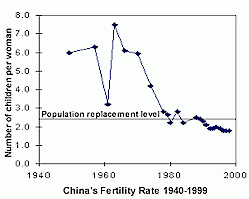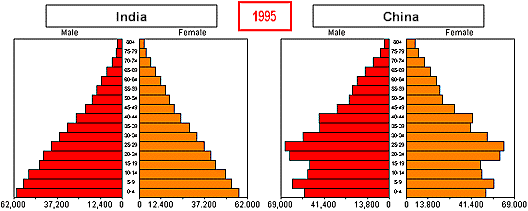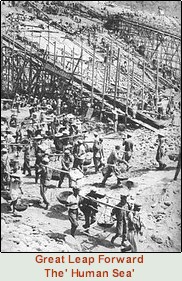China: Demographic Transition
Niu Yi Qiao, Barcelona, February 27th 2005
During the past 50 years, China has experienced demographic change at an historic scale. This has had a profound impact upon its population structure. This article by Barcelona-based Chinese student Niu Yi Qiao outlines the causes and impacts of the change.

Pre - 1949: China had experienced a century of imperial decline, natural disasters, foreign invasion and civil unrest. Life expectancy was as low as 36 years. The communists took over in 1949 after the civil war and began to modernize China.
1949 - 1958: The communists shifted their attention to economic development and together with a rich resource base there was a 10% annual growth rate in the economy. A very successful healthcare program and better nutrition brought a marked fall in the death rate, especially in infant mortality. Most of the population was still rural and people's minds were still dominated by the traditional view: more children to work the land, more children as a guarantee for security in old age. The birth rate was high and consequently the natural increase was rapid.
1958 - 1963: The communist leader Mao (who was a very successful politician and general, but not a great economic planner) was impatient with the rate of progress. What followed was the 'Great Leap Forward' policy (see below), a forced industrialization during which millions of peasants were made to leave the land to work in factories. The slogan at the time was 'overtake the British, race the Americans'. The political mismanagement and low agricultural production (there was a shortage for farmers) led to widespread famine and caused 25-30 million deaths, and a 30-35% fall in the birth rate. The death rate rose higher than the birth rate and the population experienced 5 years of natural decrease.
1962 - 1980: The 'demographic disaster' of the Great Leap Forward was followed by a baby boom in the mid-1960s and the economy began to recover. The introduction of private enterprise raised the level of food production. Throughout the 1970s politicians sought to bring about a drastic reduction in family size as they realised that a huge population threatened to outgrow the available resources. What emerged was the 'one child policy', which has been very successful in reducing birth rates. The implementation of the policy was harsh and there were strict penalties: the 'Granny Police' watched over couples of childbearing age, and if a couple had more than one child, both parents would lose their jobs. The local government would issue a fine large enough to bankrupt the family and worse, the 'illegal' child would not be given a 'household register' which was necessary for school enrolment and applying for jobs. Usually, a married couple would fulfil the policy out of fear alone, although due to industrialisation and improved education, people were becoming more receptive to new ideas. Contraception was widely practiced throughout China in order to reduce pregnancies and widen the spacing between births. A steady reduction in the birth rate resulted.
1980 - 1990: Economic growth slowed due to inflation and a trade imbalance. Due to the success of the rigid one child policy, birth rates continued to decrease although in 1984 there was a slight rise.
1990 - Today: China is
now a 'post-transitional' society, where life expectancy has reached new
heights, fertility has declined to below-replacement level, and rapid population
ageing is on the horizon.  In the
not-too-distant future, in a matter of a few decades, China's population will
start to shrink. In this process, China will also lose its position as the most
populous country in the world to India. The 'one child policy' has recently been
relaxed to a 'two child policy' in many districts in order to avoid the problems
an ageing population could bring. This has additional implications: it is
usually the rural villages that have established the 'two child policy', meaning
that in future China's population may be dominated by undereducated peasants
(who already comprise 70% of the population). In the more advanced cities, it is
not only the local government policy that maintains a low birthrates, but the
change in people's mentality. Most Chinese women have their own career and are
unwilling to sacrifice their job for children. The expense of raising a child
has also been taken into consideration by new couples. It is likely the Chinese
government will soon consider a 'three child policy' to force couples into
having more babies in order to maintain a low-cost workforce.
In the
not-too-distant future, in a matter of a few decades, China's population will
start to shrink. In this process, China will also lose its position as the most
populous country in the world to India. The 'one child policy' has recently been
relaxed to a 'two child policy' in many districts in order to avoid the problems
an ageing population could bring. This has additional implications: it is
usually the rural villages that have established the 'two child policy', meaning
that in future China's population may be dominated by undereducated peasants
(who already comprise 70% of the population). In the more advanced cities, it is
not only the local government policy that maintains a low birthrates, but the
change in people's mentality. Most Chinese women have their own career and are
unwilling to sacrifice their job for children. The expense of raising a child
has also been taken into consideration by new couples. It is likely the Chinese
government will soon consider a 'three child policy' to force couples into
having more babies in order to maintain a low-cost workforce.

China & India, 1995: Total Population by Age and Sex.
Source: UN
Population Division (1995): World Population Prospects, 1950-2050.
Chart: G.K. Heilig, 1996, IIASA-LUC
|
| What exactly is China's Population?
The one child policy has avoided the birth of 400 million people in three decades, according to the Chinese government, although, in fact, it applies to only 36% of the population and in the countryside many babies are not registered. Therefore, according to different institutions, the Chinese population in 2007 is in fact 1,600 million and not 1,300 as is officially announced. The government announced in April 2007 that the Chinese population will be less than 1,360 million in 2010 and 1,450 million in 2020. |
![]() China
Update 2007: warnings of a "population rebound" as the one child
policy is flouted
China
Update 2007: warnings of a "population rebound" as the one child
policy is flouted

 Even the blockhouses leftover from
WWII were turned into mini blast furnaces. When there was a shortage of iron
ore, local government officials led the local people (including schoolboys and
elderly grannies) to nearby hills in search for a possible source of ore. In
many areas, cooking utensils and in fact, any iron or steel-made objects
(bicycle parts, hammers, etc) were taken away to be melted and used as raw
material.
Even the blockhouses leftover from
WWII were turned into mini blast furnaces. When there was a shortage of iron
ore, local government officials led the local people (including schoolboys and
elderly grannies) to nearby hills in search for a possible source of ore. In
many areas, cooking utensils and in fact, any iron or steel-made objects
(bicycle parts, hammers, etc) were taken away to be melted and used as raw
material.